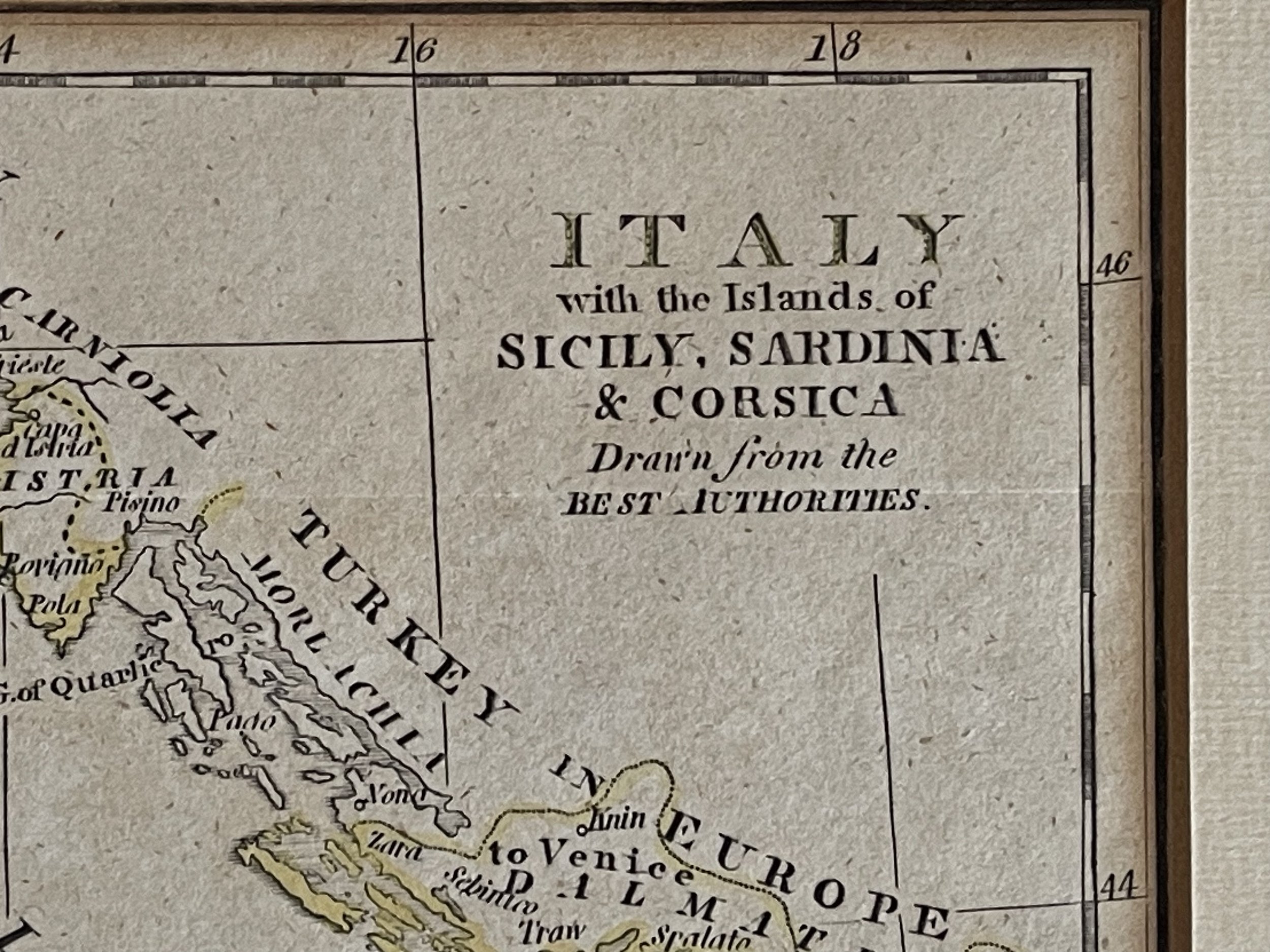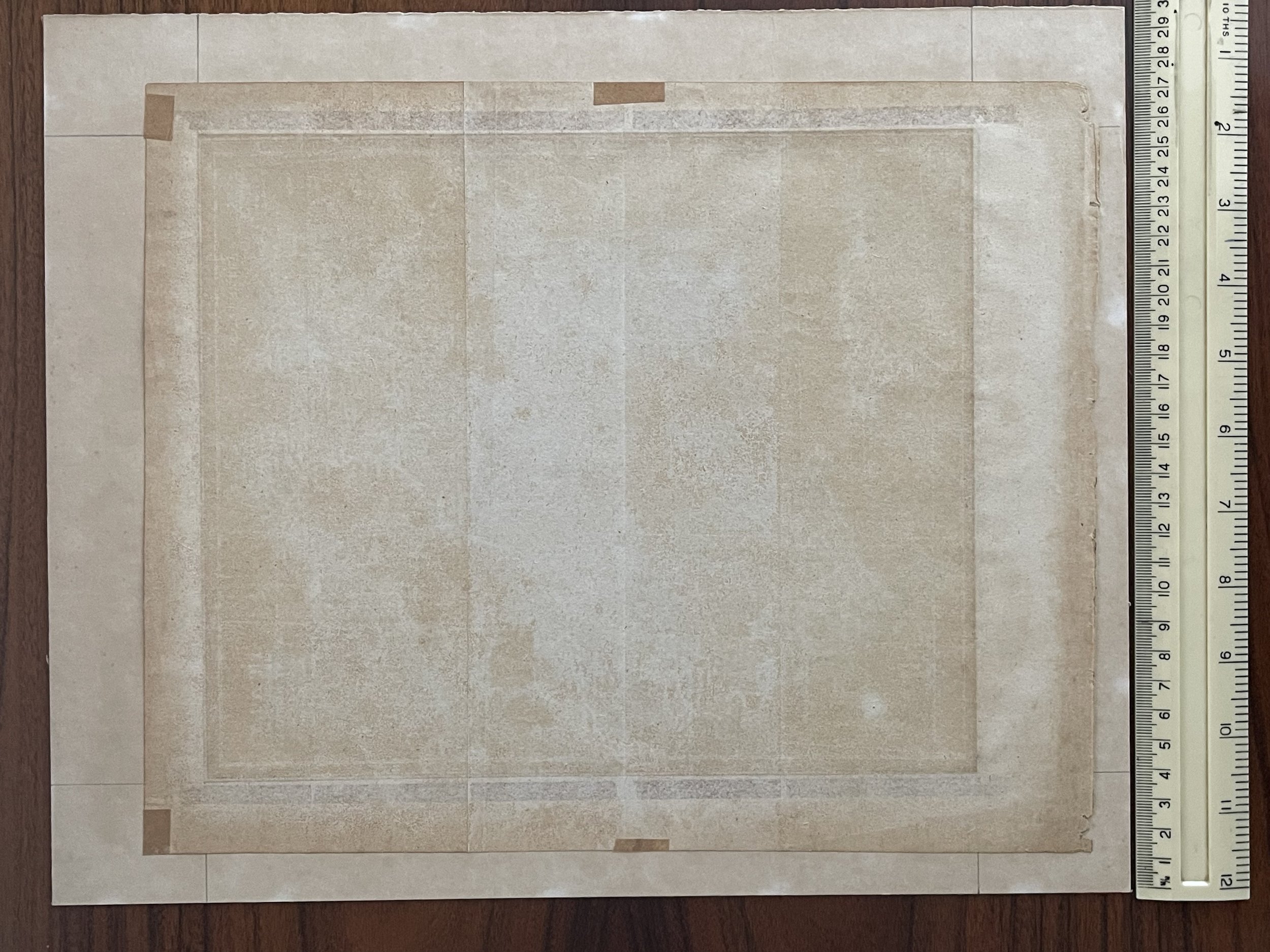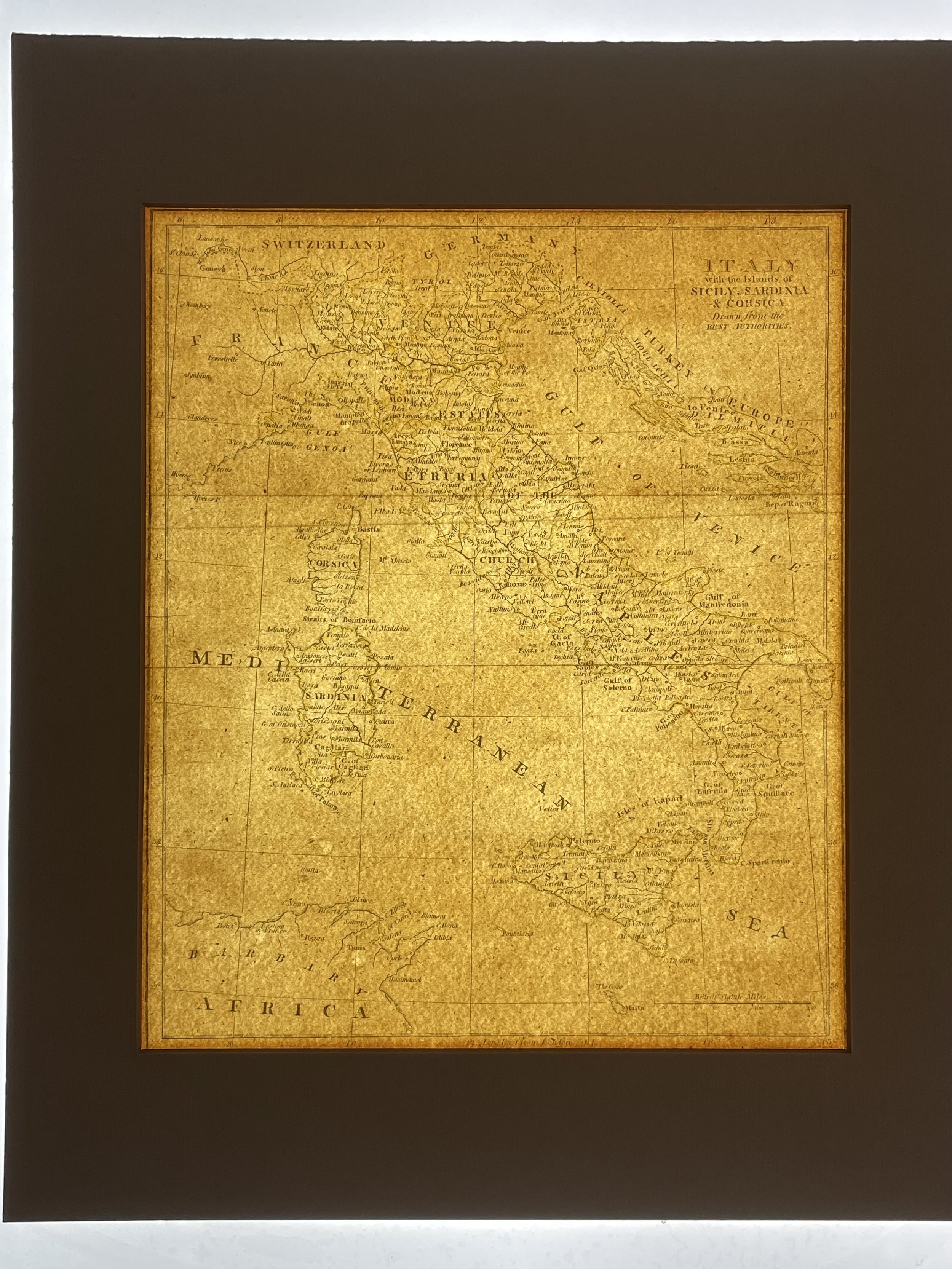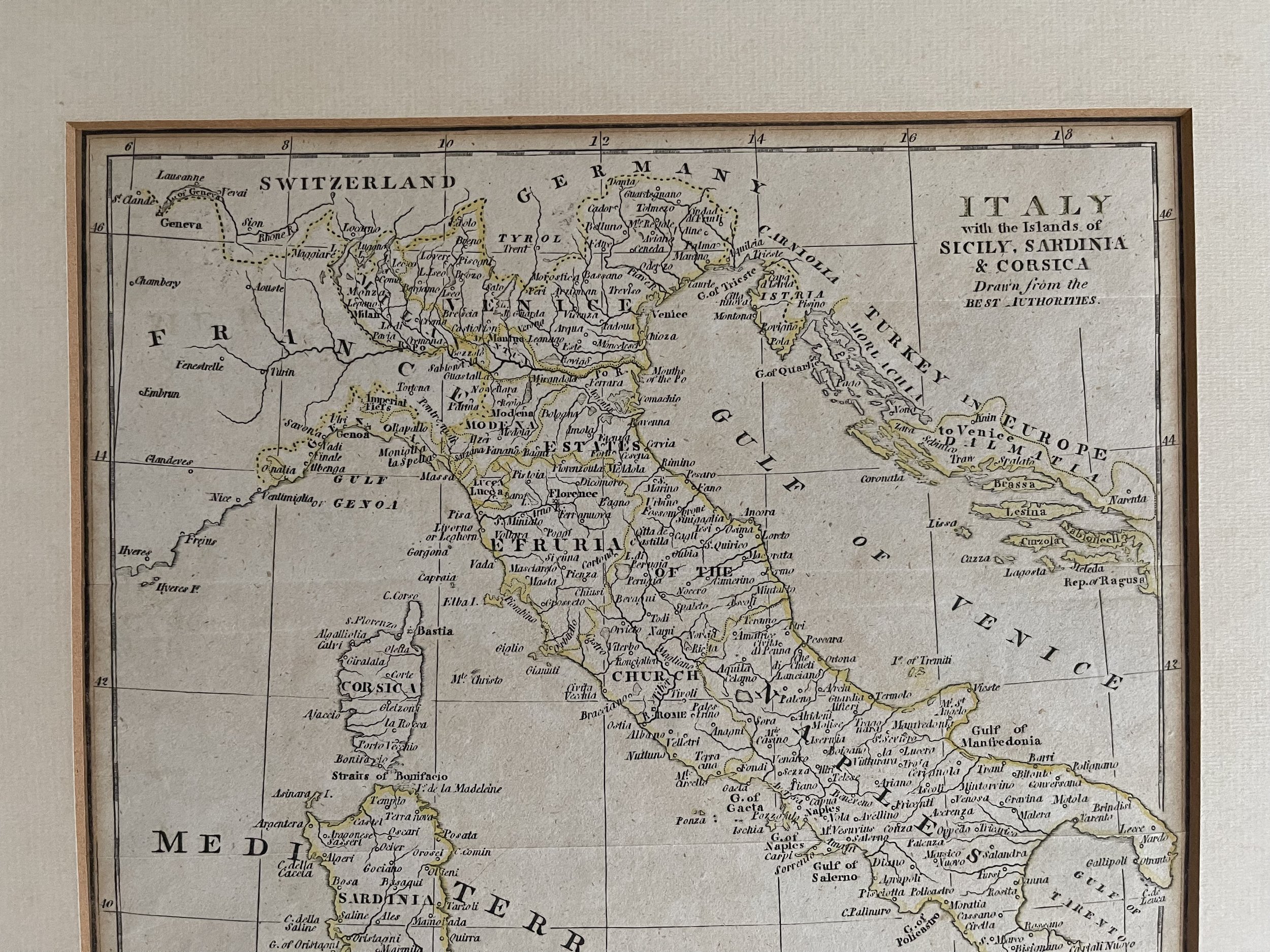Italy - with the Islands of Sicily, Sardinia & Corsica - George Alexander Cooke / J Adlard - Circ 1810
Italy with the Islands of Sicily, Sardinia & Corsica Drawn from the Best Authorities. - George Alexander Cooke - 1810
Attractive map of Italy with full original colour from 'Modern and Authentic System of Universal Geography Published by Rich. Evans, No 17 Paternoster Row, John Bourne, 17, Greenside Street, Edinburgh. Engraved by George Alexander Cooke, printed by J. Adlard, London.
George Alexander Cooke (fl. 1802-1833). Published "Modern British Traveller" (1802-1810), "Modern and authentic system of universal geography" (1802), and "Topography of Great Britain" (1822)
Decorative and delicately coloured copperplate map of EUROPE by George Alexander COOKE. Antique copperplate map with original colour; George Alexander Cooke. 28.5 x 24.0cm, 11.25 x 9.5 inches; this is a folding map. Condition: Fair: Attractive bright colours. There is nothing printed on the reverse side, which is plain. Shows all the distinct powers of Europe of the day. Poland features prominently.
This is an exquisitely detailed 1793 mad of Italy. It covers the entire peninsula of Italy as well as Piedmont, the Venetian States. It covers the entire peninsula of Italy as well as Piedmont, the Venetian States, the Dalmatian Coast, and the islands of Sardinia, Corsica, and Sicily. Colour coding defines individual regions. Italy at this time was a diverse assortment of fiefdoms, religious statelets, and republics in the process of sloughing of rigid control of powerful renaissance dynasties. This process would culminate in the French invasion of northern Italy and the creation of the Kingdom of Italy in 1804, just a few years after Wilkinson drew this map. Though Napoleonic control of Italy lasted only until 1814, the brief period of unity inspired the Italian solidarity movement to follow.
J Adlard - 1820s-1850s (circa) - Also know as J & C Adlard - British Printer & Publisher - other name: other name: Adlard, C and Adlard J. 23, Bartholomew-Close, and 39, Duke-street, West Smithfield (as J. Adlard, in 1815). Probably related to Alfred and Henry Adlard.
George Cooke (22 January 1781 – 27 February 1834), was an English line engraver.
Cooke was born in London in 1781. His father was a native of Frankfurt, Germany, who in early life settled in England and became a wholesale confectioner. At the age of 14, George Cooke was apprenticed to James Basire (1730-1802). Around the end of his apprenticeship he engraved many plates for Brewer's The Beauties of England and Wales, some in conjunction with his elder brother, William Bernard Cooke. Afterwards, he produced engravings for Pinkerton's 16-volume Collection of Voyages and Travels, during which his brother William made plans for the first edition of The Thames, to which George Cooke contributed two plates. This work was followed by Picturesque Views on the Southern Coast of England, from drawings made principally by Turner. It was commenced in 1814 and completed in 1826, and George Cooke engraved 15 plates, nearly one-third of the total, and some vignettes. Next appeared an improved edition of The Thames, for which he engraved the 'Launch of the Nelson' and the 'Fair on the Thames,' after Luke Clennell, and the 'Opening of Waterloo Bridge,' after Philip Reinagle. Between 1817 and 1833 he produced, in connection with Loddiges of Hackney, London a number of plates for the Botanical Cabinet,'[4] and about the same time he engraved some of the plates, after Turner, for Hakewill's Picturesque Tour of Italy, 1820,[5] and Sir Walter Scott's Provincial Antiquities and Picturesque Scenery of Scotland, 1826, in which latter work should be especially noted "Edinburgh from the Calton Hill". To these were added plates for Thomas Allason's Antiquities of Pola, 1819, John Spencer-Stanhope's Olympia, (published by Rodwell and Martin, 1824), and D'Oyly and Mant's Bible, as well as some of those for John Hughes' Views in the South of France, chiefly on the Rhone, after Peter De Wint.
Besides these Cooke engraved a few plates for the publications of the Dilettanti Society, and for the Ancient Marbles in the British Museum, and the Ancient Terracottas[9] in the same collection, and single plates after Turner of a "View of Gledhow" for Whitaker's Loidis and Elmete, and "Wentworth House" for Thomas Dunham Whitaker's History of Richmondshire. In 1815, he produced some lithographs for Henry Holland's Travels in the Ionian Isles, .... He also engraved the "Iron Bridge at Sunderland", from an outline by Edward Blore; for Surtees's History of Durham; and the "Monument of Sir Francis Bacon" in St Michael's Church, St Albans, for Robert Clutterbuck's History of Hertfordshire.
In 1825, Cooke finished his fine engraving of "Rotterdam", from Augustus Wall Callcott's picture belonging to the Earl of Essex, and shortly afterwards issued a prospectus announcing a series of plates from Callcott's works, of which two, "Antwerp" and "Dover", were begun and considerably advanced when vexation at the loss of the proceeds of his 'Rotterdam,'caused by the failure of his agent, led to their abandonment. He then began, in 1826, the Views in London and its Vicinity, engraved from drawings by Callcott, Stanfield, Roberts, Prout, Stark, Harding, Cotman, and Havell, ending with the 12th issue just before his death.
In 1833, Cooke produced Views of the Old and New London Bridges, executed conjointly with his son, Edward William Cooke, who also made the drawings. He also produced plates for Frederick Nash's Views in Paris, Colonel Batty's Views of European Cities, Baron Taylor's Spain published by Robert Jennings, Rhodes's Peak Scenery and Yorkshire Scenery, several for Stark's Scenery of the Rivers of Norfolk, and one of "Southampton", after Copley Fielding, for the Gallery of the Society of Painters in Water Colours. Cooke was one of the original members of the "Society of Associated Engravers", who joined together for the purpose of engraving the pictures in the National Gallery, and two of his plates were in preparation at the time of his death. He likewise attempted engraving in mezzotint, and in that style executed a plate of 'Arundel Castle,' after Turner; but it was not a success and was never published.
Cooke died of 'brain fever' on 27 February 1834 at Barnes, where he was buried.
Italy with the Islands of Sicily, Sardinia & Corsica Drawn from the Best Authorities. - George Alexander Cooke - 1810
Attractive map of Italy with full original colour from 'Modern and Authentic System of Universal Geography Published by Rich. Evans, No 17 Paternoster Row, John Bourne, 17, Greenside Street, Edinburgh. Engraved by George Alexander Cooke, printed by J. Adlard, London.
George Alexander Cooke (fl. 1802-1833). Published "Modern British Traveller" (1802-1810), "Modern and authentic system of universal geography" (1802), and "Topography of Great Britain" (1822)
Decorative and delicately coloured copperplate map of EUROPE by George Alexander COOKE. Antique copperplate map with original colour; George Alexander Cooke. 28.5 x 24.0cm, 11.25 x 9.5 inches; this is a folding map. Condition: Fair: Attractive bright colours. There is nothing printed on the reverse side, which is plain. Shows all the distinct powers of Europe of the day. Poland features prominently.
This is an exquisitely detailed 1793 mad of Italy. It covers the entire peninsula of Italy as well as Piedmont, the Venetian States. It covers the entire peninsula of Italy as well as Piedmont, the Venetian States, the Dalmatian Coast, and the islands of Sardinia, Corsica, and Sicily. Colour coding defines individual regions. Italy at this time was a diverse assortment of fiefdoms, religious statelets, and republics in the process of sloughing of rigid control of powerful renaissance dynasties. This process would culminate in the French invasion of northern Italy and the creation of the Kingdom of Italy in 1804, just a few years after Wilkinson drew this map. Though Napoleonic control of Italy lasted only until 1814, the brief period of unity inspired the Italian solidarity movement to follow.
J Adlard - 1820s-1850s (circa) - Also know as J & C Adlard - British Printer & Publisher - other name: other name: Adlard, C and Adlard J. 23, Bartholomew-Close, and 39, Duke-street, West Smithfield (as J. Adlard, in 1815). Probably related to Alfred and Henry Adlard.
George Cooke (22 January 1781 – 27 February 1834), was an English line engraver.
Cooke was born in London in 1781. His father was a native of Frankfurt, Germany, who in early life settled in England and became a wholesale confectioner. At the age of 14, George Cooke was apprenticed to James Basire (1730-1802). Around the end of his apprenticeship he engraved many plates for Brewer's The Beauties of England and Wales, some in conjunction with his elder brother, William Bernard Cooke. Afterwards, he produced engravings for Pinkerton's 16-volume Collection of Voyages and Travels, during which his brother William made plans for the first edition of The Thames, to which George Cooke contributed two plates. This work was followed by Picturesque Views on the Southern Coast of England, from drawings made principally by Turner. It was commenced in 1814 and completed in 1826, and George Cooke engraved 15 plates, nearly one-third of the total, and some vignettes. Next appeared an improved edition of The Thames, for which he engraved the 'Launch of the Nelson' and the 'Fair on the Thames,' after Luke Clennell, and the 'Opening of Waterloo Bridge,' after Philip Reinagle. Between 1817 and 1833 he produced, in connection with Loddiges of Hackney, London a number of plates for the Botanical Cabinet,'[4] and about the same time he engraved some of the plates, after Turner, for Hakewill's Picturesque Tour of Italy, 1820,[5] and Sir Walter Scott's Provincial Antiquities and Picturesque Scenery of Scotland, 1826, in which latter work should be especially noted "Edinburgh from the Calton Hill". To these were added plates for Thomas Allason's Antiquities of Pola, 1819, John Spencer-Stanhope's Olympia, (published by Rodwell and Martin, 1824), and D'Oyly and Mant's Bible, as well as some of those for John Hughes' Views in the South of France, chiefly on the Rhone, after Peter De Wint.
Besides these Cooke engraved a few plates for the publications of the Dilettanti Society, and for the Ancient Marbles in the British Museum, and the Ancient Terracottas[9] in the same collection, and single plates after Turner of a "View of Gledhow" for Whitaker's Loidis and Elmete, and "Wentworth House" for Thomas Dunham Whitaker's History of Richmondshire. In 1815, he produced some lithographs for Henry Holland's Travels in the Ionian Isles, .... He also engraved the "Iron Bridge at Sunderland", from an outline by Edward Blore; for Surtees's History of Durham; and the "Monument of Sir Francis Bacon" in St Michael's Church, St Albans, for Robert Clutterbuck's History of Hertfordshire.
In 1825, Cooke finished his fine engraving of "Rotterdam", from Augustus Wall Callcott's picture belonging to the Earl of Essex, and shortly afterwards issued a prospectus announcing a series of plates from Callcott's works, of which two, "Antwerp" and "Dover", were begun and considerably advanced when vexation at the loss of the proceeds of his 'Rotterdam,'caused by the failure of his agent, led to their abandonment. He then began, in 1826, the Views in London and its Vicinity, engraved from drawings by Callcott, Stanfield, Roberts, Prout, Stark, Harding, Cotman, and Havell, ending with the 12th issue just before his death.
In 1833, Cooke produced Views of the Old and New London Bridges, executed conjointly with his son, Edward William Cooke, who also made the drawings. He also produced plates for Frederick Nash's Views in Paris, Colonel Batty's Views of European Cities, Baron Taylor's Spain published by Robert Jennings, Rhodes's Peak Scenery and Yorkshire Scenery, several for Stark's Scenery of the Rivers of Norfolk, and one of "Southampton", after Copley Fielding, for the Gallery of the Society of Painters in Water Colours. Cooke was one of the original members of the "Society of Associated Engravers", who joined together for the purpose of engraving the pictures in the National Gallery, and two of his plates were in preparation at the time of his death. He likewise attempted engraving in mezzotint, and in that style executed a plate of 'Arundel Castle,' after Turner; but it was not a success and was never published.
Cooke died of 'brain fever' on 27 February 1834 at Barnes, where he was buried.
Italy with the Islands of Sicily, Sardinia & Corsica Drawn from the Best Authorities. - George Alexander Cooke - 1810
Attractive map of Italy with full original colour from 'Modern and Authentic System of Universal Geography Published by Rich. Evans, No 17 Paternoster Row, John Bourne, 17, Greenside Street, Edinburgh. Engraved by George Alexander Cooke, printed by J. Adlard, London.
George Alexander Cooke (fl. 1802-1833). Published "Modern British Traveller" (1802-1810), "Modern and authentic system of universal geography" (1802), and "Topography of Great Britain" (1822)
Decorative and delicately coloured copperplate map of EUROPE by George Alexander COOKE. Antique copperplate map with original colour; George Alexander Cooke. 28.5 x 24.0cm, 11.25 x 9.5 inches; this is a folding map. Condition: Fair: Attractive bright colours. There is nothing printed on the reverse side, which is plain. Shows all the distinct powers of Europe of the day. Poland features prominently.
This is an exquisitely detailed 1793 mad of Italy. It covers the entire peninsula of Italy as well as Piedmont, the Venetian States. It covers the entire peninsula of Italy as well as Piedmont, the Venetian States, the Dalmatian Coast, and the islands of Sardinia, Corsica, and Sicily. Colour coding defines individual regions. Italy at this time was a diverse assortment of fiefdoms, religious statelets, and republics in the process of sloughing of rigid control of powerful renaissance dynasties. This process would culminate in the French invasion of northern Italy and the creation of the Kingdom of Italy in 1804, just a few years after Wilkinson drew this map. Though Napoleonic control of Italy lasted only until 1814, the brief period of unity inspired the Italian solidarity movement to follow.
J Adlard - 1820s-1850s (circa) - Also know as J & C Adlard - British Printer & Publisher - other name: other name: Adlard, C and Adlard J. 23, Bartholomew-Close, and 39, Duke-street, West Smithfield (as J. Adlard, in 1815). Probably related to Alfred and Henry Adlard.
George Cooke (22 January 1781 – 27 February 1834), was an English line engraver.
Cooke was born in London in 1781. His father was a native of Frankfurt, Germany, who in early life settled in England and became a wholesale confectioner. At the age of 14, George Cooke was apprenticed to James Basire (1730-1802). Around the end of his apprenticeship he engraved many plates for Brewer's The Beauties of England and Wales, some in conjunction with his elder brother, William Bernard Cooke. Afterwards, he produced engravings for Pinkerton's 16-volume Collection of Voyages and Travels, during which his brother William made plans for the first edition of The Thames, to which George Cooke contributed two plates. This work was followed by Picturesque Views on the Southern Coast of England, from drawings made principally by Turner. It was commenced in 1814 and completed in 1826, and George Cooke engraved 15 plates, nearly one-third of the total, and some vignettes. Next appeared an improved edition of The Thames, for which he engraved the 'Launch of the Nelson' and the 'Fair on the Thames,' after Luke Clennell, and the 'Opening of Waterloo Bridge,' after Philip Reinagle. Between 1817 and 1833 he produced, in connection with Loddiges of Hackney, London a number of plates for the Botanical Cabinet,'[4] and about the same time he engraved some of the plates, after Turner, for Hakewill's Picturesque Tour of Italy, 1820,[5] and Sir Walter Scott's Provincial Antiquities and Picturesque Scenery of Scotland, 1826, in which latter work should be especially noted "Edinburgh from the Calton Hill". To these were added plates for Thomas Allason's Antiquities of Pola, 1819, John Spencer-Stanhope's Olympia, (published by Rodwell and Martin, 1824), and D'Oyly and Mant's Bible, as well as some of those for John Hughes' Views in the South of France, chiefly on the Rhone, after Peter De Wint.
Besides these Cooke engraved a few plates for the publications of the Dilettanti Society, and for the Ancient Marbles in the British Museum, and the Ancient Terracottas[9] in the same collection, and single plates after Turner of a "View of Gledhow" for Whitaker's Loidis and Elmete, and "Wentworth House" for Thomas Dunham Whitaker's History of Richmondshire. In 1815, he produced some lithographs for Henry Holland's Travels in the Ionian Isles, .... He also engraved the "Iron Bridge at Sunderland", from an outline by Edward Blore; for Surtees's History of Durham; and the "Monument of Sir Francis Bacon" in St Michael's Church, St Albans, for Robert Clutterbuck's History of Hertfordshire.
In 1825, Cooke finished his fine engraving of "Rotterdam", from Augustus Wall Callcott's picture belonging to the Earl of Essex, and shortly afterwards issued a prospectus announcing a series of plates from Callcott's works, of which two, "Antwerp" and "Dover", were begun and considerably advanced when vexation at the loss of the proceeds of his 'Rotterdam,'caused by the failure of his agent, led to their abandonment. He then began, in 1826, the Views in London and its Vicinity, engraved from drawings by Callcott, Stanfield, Roberts, Prout, Stark, Harding, Cotman, and Havell, ending with the 12th issue just before his death.
In 1833, Cooke produced Views of the Old and New London Bridges, executed conjointly with his son, Edward William Cooke, who also made the drawings. He also produced plates for Frederick Nash's Views in Paris, Colonel Batty's Views of European Cities, Baron Taylor's Spain published by Robert Jennings, Rhodes's Peak Scenery and Yorkshire Scenery, several for Stark's Scenery of the Rivers of Norfolk, and one of "Southampton", after Copley Fielding, for the Gallery of the Society of Painters in Water Colours. Cooke was one of the original members of the "Society of Associated Engravers", who joined together for the purpose of engraving the pictures in the National Gallery, and two of his plates were in preparation at the time of his death. He likewise attempted engraving in mezzotint, and in that style executed a plate of 'Arundel Castle,' after Turner; but it was not a success and was never published.
Cooke died of 'brain fever' on 27 February 1834 at Barnes, where he was buried.
Code : A214
Cartographer : Cartographer / Engraver / Publisher: George Alexander Cooke / J Adlard
Date : Publication Place / Date - 1801
Size : Sheet size: Image Size: 28.5 x 24.0cm, 11.25 x 9.5 inches
Availability : Available
Type - Genuine - Antique
Grading A-
Where Applicable - Folds as issued. Light box photo shows the folio leaf centre margin hinge ‘glue’, this is not visible otherwise.
Tracked postage, in casement. Please contact me for postal quotation outside of the UK.





